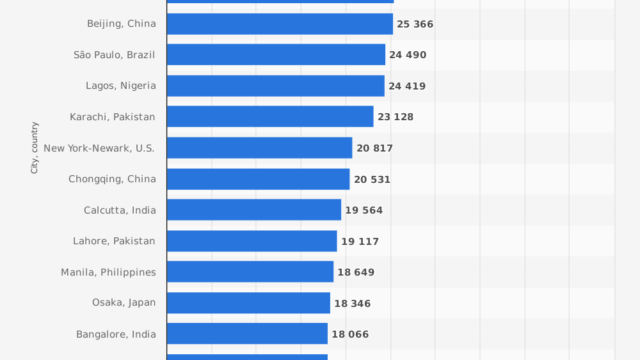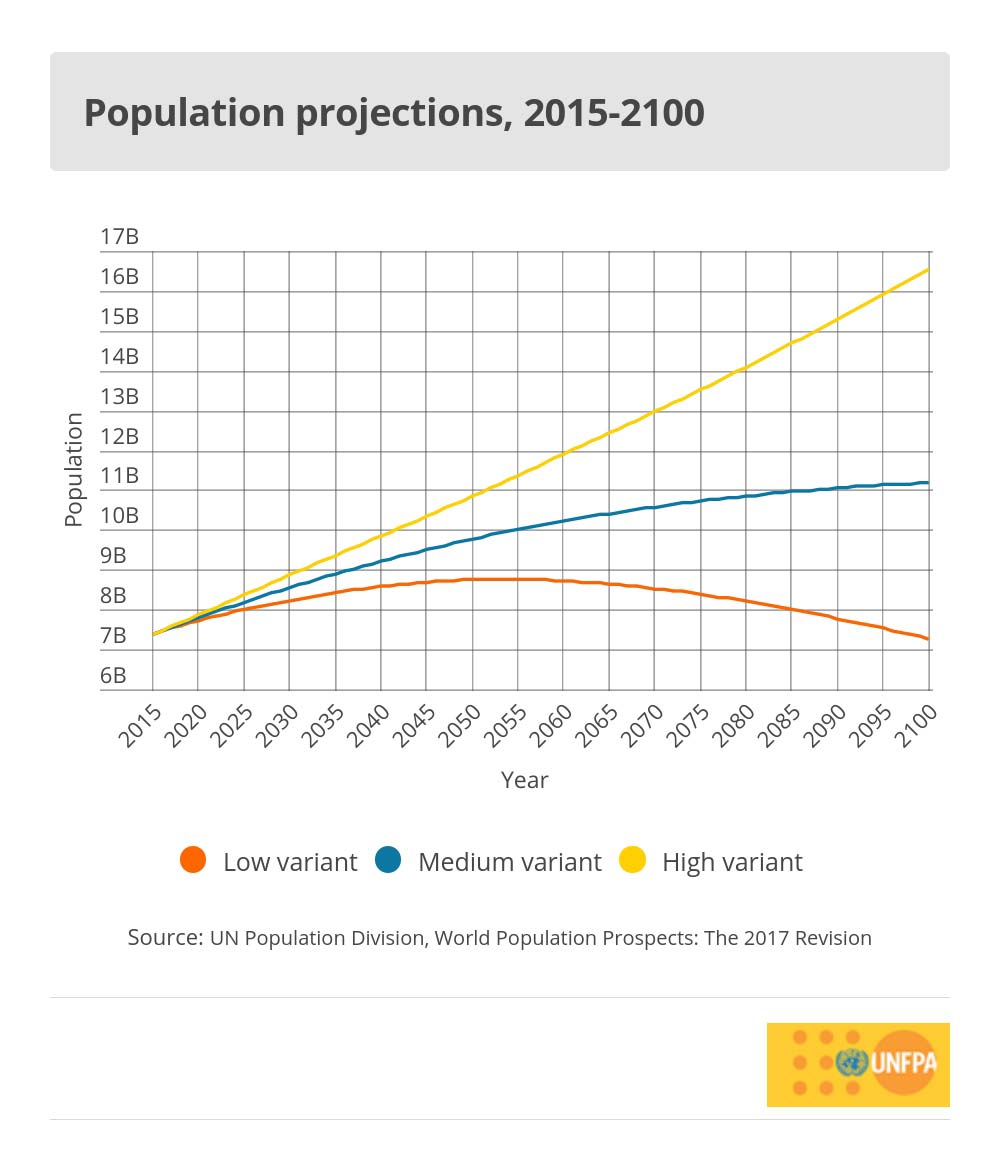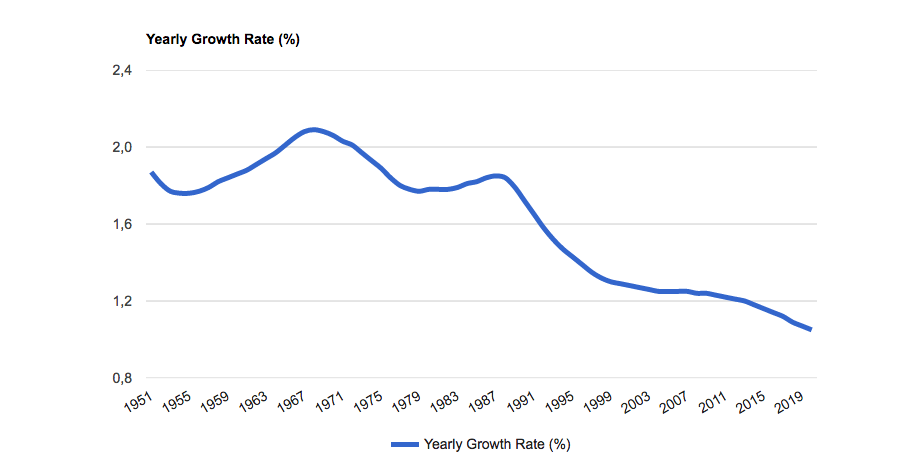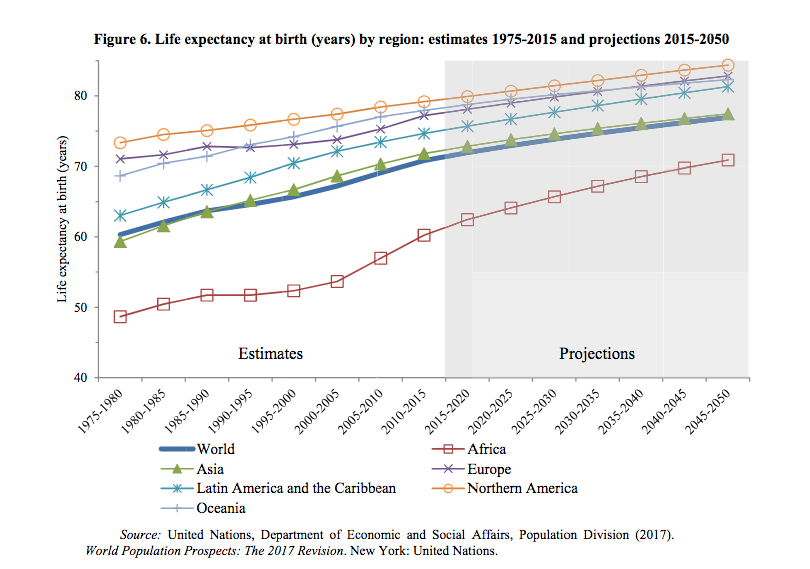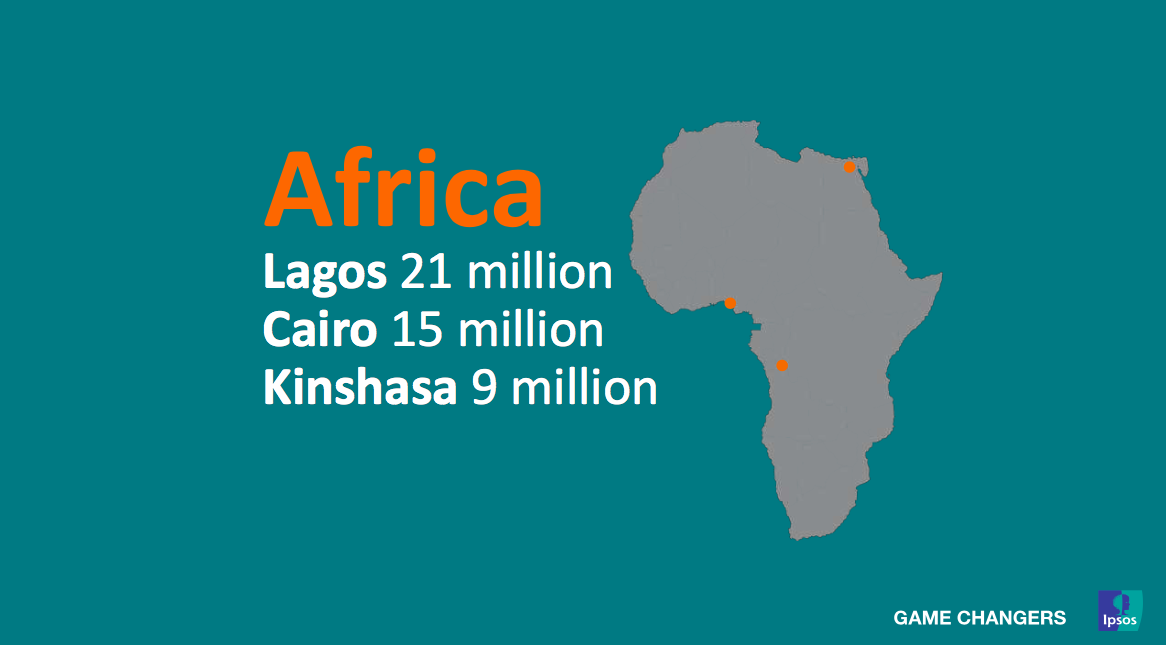Indice degli argomenti
The growth of the global population
By 2050, about 10 billion people will live all over the world. Thousands of years (from the onset of mankind until 1800) were needed before the global population had reached its first billion, but a couple of centuries were enough to reach today’s 7.7 billion: the second billion was reached in 130 years (1930), the third billion in 30 years (1960), the fourth billion in 15 years (1974) and the fifth billion in just 13 years (1987). (source: Worldometers).
During the 20th century, the global population rose from 1.65 billion to 6 billion, in 1970 there were about half of the people living today. After this peak, the rate of growth has progressively slowed down, but nevertheless, the global population is growing, although not anywhere by the same token: in the poorest countries the rate of fertility is still high and is expected to lead to the doubling, even tripling, of their population. In particular, after 2060, the demographic upswing will be driven almost purely by fertility levels in the least developed countries throughout the world. Africa, mainly, but also the Middle East and Asia.
The growth of the world’s population over the last two centuries is in fact due to advances in medicine and improved living standards, leading to a sharp reduction in infant and maternal mortality, and to increased life expectancy. In the less developed countries, on the other hand, improvements in living conditions and health care are goals that only now can be reached, resulting in a higher survival rate and longer life expectancy. However, the very fact that the population growth rate on a global basis is decreasing, leads to a net increase of individuals on the planet as it refers to a progressively larger population.
These aggregated global data, however, are not enough to understand what is going on.
Demographic change is being polarized in two directions: on the one hand, the world, including Italy, has a negative growth rate (the well-known problem of ‘not having children’) and a strong ageing of the population (in Italy and Japan the average age is 48 years); on the other hand, in emerging countries, the growth rate is still very high and the average age is rather low (in all African countries the rate is around 16-20). That’s what PWC said about:
The pace of change will vary substantially from region to region. Africa’s fastest-growing population is set to double by 2050, while Europe’s population is set to shrink. Fertility in Latin America will remain higher than mortality. The average age in Japan in 2050 will be 53 years – in Nigeria it will be 23.
This development has far-reaching local and global impacts. Bold policies will need to be implemented in all countries to cope with these demographic changes. In North America and Europe, as well as in much of Asia and Latin America, sustaining an ageing population would require greater female and older people to join the workforce, and perhaps even higher levels of immigration. Africa’s youngest population is a great opportunity, but appropriate political conditions will be needed to maximize the benefits of this demographic element: younger people are an asset only when sufficient employment can be generated.
The majority of the world’s population will be resident, in the coming decades, in the geographical area encompassing India, Pakistan, China, Indonesia, the Philippines, Bangladesh and Vietnam.
How long will the population keep growing?
The pioneering entrepreneur Elon Musk, riding on the assumptions of some demographics experts, has already on several occasions pointed out with concern that the demographic boom will not last forever, there will be a demographic implosion that could even lead to the collapse of our society. Undoubtedly, the current trend puts at risk the sustainability of social welfare systems such as the pension system or the health care system itself. It is therefore up to governments to identify adequate policies to avoid the collapses that, unadjusted, will inevitably occur.
A recent book, Empty Planet, written by journalist John Ibbitson and political expert Darrell Bricker (here an interview on Wired) comes to an even more radical conclusion, disavowing the predictive models of the United Nations, which in their opinion only take into account three variables: fertility, death and migration rates. In no way do they take into account the ‘knowledge’ factor, i.e. how even through internet access also in the poorest countries, people, and women in particular, are able to better understand the issues of sexuality and birth control, of their rights, changing their perspective on the traditional rules around families and fertility. Rates of population growth will be affected, and instead of increasing, population growth will stabilize in about 30 years – and then shrink, perhaps forever.
From a data point of view, long-term predictions on a topic like this are unlikely, as the variables that may be at stake over the years are generally unavailable. However, the United Nations has attempted to make a few: according to the mid-term analysis, by the year 2300 the world population will be just under 9 billion. After reaching the peak of increase, from 2050 onwards it will begin to decrease progressively. In the long term, the highest population growth is expected in Africa. The areas currently known as India, China, the United States and Pakistan will remain in their current rank as the most densely populated areas worldwide.
What will happen?
At first glance, resource consumption: does the planet have sufficient natural reserves for all this population? Food, water, energy?
How will it affect our already poor environmental situation?
1.5 million more people are registered every week all over the world, every second 5 people are born and two die. The resources of our planet are not limitless: the human demand for water, land, forests and energy can’t climb over a given limit, even nowadays the natural ecosystem, plants, animals and climate pay the price of anthropization.
According to the Population Media Center, “The environmental sustainability we need must be achieved by stabilizing the world’s population”.
The risks we face are therefore those associated with overpopulation and the worsening of the environmental downturn and climate change problems.
The global ageing

While all countries worldwide will experience an ageing population, Europe, Asia and Latin America are experiencing such an effect: a drop in the working age population in Europe will be particularly strong, with already worrying impacts on social security, health, economic and social systems. Asia, for example, counts nine working age people to support each ageing person on average (although trends are very different across countries). By 2050, this number is expected to fall by half to four people. For every four people of working age per elderly person in Europe by 2015, there will only be two by 2050, according to PWC. Addressing this shortage will require greater labor force engagement by two groups: women and the very same older people.
WEF places a lot of emphasis on this issue, highlighting the risks but also the opportunities offered by the topic. Global projections for 2050 are staggering: 1.6 billion people over 65 and $400 trillion for missing pensions. For the average pensioner, who will struggle to pay basic expenses such as housing, food and health, this will result in a deficit of $250,000. In recent years, there has been a growing awareness among nations that ageing and longevity trends are threatening both the emerging and the developed economies. Due to demographic conditions, traditional pay-as-you-go pension systems can no longer be the sole appropriate source of pension income. This is due in part to the negative impact of other aspects: increasing urbanization, which disrupts family bonds and makes the network of social solidarity weaker; and the growth of ‘moonlighting’, which does not support the retirement system and deprives the worker of social security.
Governments and business organizations must deal with this issue in a synergistic way in order to obtain employment targets, on the one hand, and to increase the number of workers linked to the retirement system, on the other; it is necessary to encourage people to protect themselves by means of private forms of savings and social security so as to guarantee a worry-free ageing.
The ageing of the population is set to become one of the most significant social transformations of the 21st century, impacting on almost any social area, from employment and the economic system (financial services, demand for goods and services, such as housing, transportation and social protection) to the basics of society, such as family structures and age-related links.
According to World Population Prospects 2017 data, the number of elderly people – aged 60 and over – is expected to more than double by 2050 and more than triple by 2100, rising from 962 million in 2017 to 2.1 billion in 2050 and 3.1 billion in 2100. Globally, the population aged 60 and over is growing faster than all younger age groups.
Lifespan
According to the United Nations, life expectancy at birth globally increased by 3.6 years between 2000-2005 and 2010-2015, from 67.2 to 70.8 years. All regions shared the increase in life-expectancy in this period, but the largest gains were recorded in Africa, where life expectancy increased by 6.6 years between these two periods, after increasing by less than 2 years compared to the previous decade. Life expectancy in Africa in 2010-2015 was 60.2 years, compared to 71.8 in Asia, 74.6 in Latin America and the Caribbean, 77.2 in Europe, 77.9 in Oceania and 79.2 in North America.
The longer average life requires today to rethink the same model of human life cycle divided into 3 stages, where the third age (from 65) was once the final step. By now we are talking about the fourth and even fifth age, or perhaps the birthmarks should simply be moved at least 10-15 years ahead, as experts and scientists suggest: the 75-80 years of today are the 65 of a time, life expectancy has been greatly increased and health has also improved. The longest life is not a tiring, a little badly dragged on over the years: an interesting research carried out by BNP Paribas Cardif, in Italy, where the aging is among the highest worldwide, among the over 65 has shown that today the senior (so to speak) is no longer connected with the traditional one: well-being and health increase, the attitude towards life is more positive, is active, in our country represent a real pillar of families and communities, according to economic data.
Today, the over 65 are about 13,672,000 (ISTAT), or 22.6% of the current population and will be 34 million by 2050 (34%): the commitment of grandparents (in the care of grandchildren) is now worth 24 billion euros, the economic support to children and their families is worth 5.4 billion, employ 3 million family caregivers, contribute to the tourism industry for 6 billion euros per year (source: Federanziani).
Over 65s are now a much more attractive target group for financial and insurance services than the Millennials.
The question many experts wonder is whether human longevity will continue to improve or, on the contrary, lag behind.
Even in this case, long-term forecasts are difficult to make, the variables are many, among the best scenario and the worst situation there are huge differences, mainly due to the involvement or not of society with respect to well-known endangered human health and longevity factors (ranging from contagious diseases such as HIV to malnutrition in poor countries, to the problems of developed countries such as obesity and generally poor nutrition, smoking, alcohol, pollution).
Among the most gloomy trends, a survey by The Lancet, carried out at the Washington University, offers forecasts of future life expectancy in 195 countries in 2040 along with assumptions that risk factors and early mortality related to hypertension, obesity, hyperglycemia, smoking, alcohol and pollution will worsen under specific conditions.
“The ageing process is much more pliable than we thought and we are still, in a way, trying to catch up in our research to understand what this pliability comes from, how far we could go and, in our societies, we are trying to make sense of a world where we keep getting older”. (Thomas Kirkwood, Associate Dean for Ageing at the University of Newcastle)
From an insurance point of view, Odette Cesari, Axa IM, in this interview, argues that the focus today should be on life expectancy calculated from the third age (65 years) rather than considering it according to the traditional method, i.e. from birth. Greater longevity means that life as a pensioner is longer, in other words the period when people are no longer in working age but rather when pension ‘products’ that will last longer than initially assumed are implemented.
Megacity
Megacity are the cities with more than 10 million inhabitants, in 1950 there were two: New York and Tokyo. Today there are 33 and will be at least 40 by 2030. The Shanghai area could already in the next two years turn into a gigacity with a population of 170 million inhabitants, twice as many as Germany, according to Allianz in this article. By 2050, 68% of the world’s population (compared to 55% today) will be living in cities, in megacities. This boost to urbanization, combined with the overall growth of the world’s population, will bring not only a further 2.5 billion people to urban areas by 2050, (90% of this increase in Asia and Africa), but also to the exponential growth of some cities, in specific countries. India, China and Nigeria will account for 35% of the world’s projected urban population growth between 2018 and 2050. By 2050, India is expected to have added 416 million city dwellers, China 255 million and Nigeria 189 million. The interactive map below produced by the World Resources Institute shows the cities in horizontal and vertical expansion.
The world’s urban population grew rapidly from 751 million in 1950 to 4.2 billion in 2018. Asia, despite its relatively lower level of urbanization, hosts 54% of the world’s urban population, followed by Europe and Africa with 13% each.
Today, the most densely populated regions include North America (with 82% of the population living in urban areas in 2018), Latin America and the Caribbean (81%), Europe (74%) and Oceania (68%). The level of urbanization in Asia is currently about 50%. In contrast, Africa remains predominantly rural, with 43% of the population living in urban areas.
However, in the coming years Africa will achieve the highest rates of urban population growth, overtaking even Asia.
The trend towards megacity raises a number of environmental, social and even political issues. The expansion of cities should be managed, as an uncontrolled growth, such as the one that is already taking place in low-income countries, is equal to creating giant slums with a high degradation, loss of rights, social involution, widespread crime.
For example, Lagos, in Nigeria, is now a city of 22 million inhabitants, blasted from small town to megalopolis in a few years, extending horizontally into slums for 452 square miles: less than 10% of people live in houses with sewer connections; less than 20% have access to tap water. An idea very far from that of hyper-connected ‘smart cities’, offering maximum well-being to its inhabitants.
The ideal megalopolis, the smart city, is a model of sustainability where technology, innovation and connectivity offer the best opportunity to improve the life quality of all its inhabitants through a positive environmental impact, access to resources and personal services. According to WEF there are 5 main challenges facing megacity: environmental protection, use of raw materials (water, food, energy), social inequalities, technology and government.
Urbanization and megalopolises are redefining the way human beings live, their lifestyle, their priorities, needs and concerns and represent a major challenge for the insurance industry.
New risks facing mega-cities include natural disasters, epidemics, terrorism and cyber attacks.
